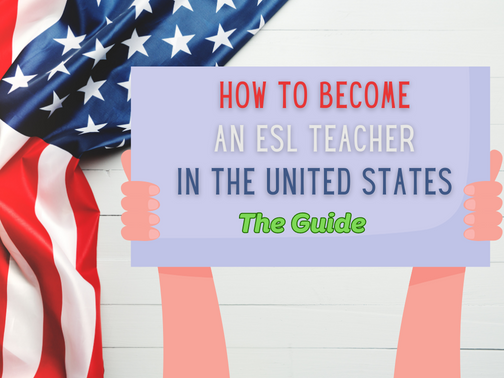Meet Beenish Aslam, an accomplished MPhil scholar, and writer at Wonderful World English. Beenish has a wealth of experience in education, and we sought out her expertise to provide fresh insights into this dynamic world.
Education is a powerful tool not just for knowledge acquisition but also for bridging cultural and linguistic divides. This is especially evident in the role of an ESL (English as a Second Language) teacher.
In the United States, the demand for skilled ESL teachers is on the rise due to the increasing diversity in schools and communities.
Pursuing a career as an ESL teacher opens doors to various educational environments.
It allows for meaningful cross-cultural interactions and the opportunity to significantly impact non-native English speakers’ lives.
Individuals must navigate a series of educational and certification requirements to embark on a career as an ESL teacher.
Becoming an ESL teacher in the U.S. requires specific qualifications. Each state has its own set of requirements, but generally, an ESL teacher should have at least a bachelor’s degree and a relevant teaching certification, like TESOL. There are many opportunities for teaching English to qualified individuals in the United States.
Prospective ESL educators often complete specialized training programs to gain in-depth knowledge of linguistics, pedagogy, and curriculum development tailored to teaching English language learners.
Licensure is critical and requirements can vary significantly from state to state.
Key Takeaways
- ESL teachers play a critical role in fostering linguistic proficiency and cultural integration.
- A bachelor’s degree coupled with specialized training in ESL is typically required to enter the field.
- State-specific licensing is a crucial step toward becoming a professionally recognized ESL teacher.

Understanding ESL and Its Importance
ESL plays a pivotal role in education, especially in a culturally diverse setting like the United States.
This section delves into what ESL is and the growing need for ESL educators:
Defining ESL and Its Role in Education
ESL refers to the practice of teaching English to individuals whose first language isn’t English.
It encompasses a wide range of techniques, teaching materials, and educational contexts where English language learners (ELL) work to achieve proficiency in English.
In educational settings, ESL instruction targets the specific language skills of reading, writing, listening, and speaking, in addition to cultural nuances of the English language.
The Rising Demand for ESL Teachers
The demand for ESL teachers has escalated due to a multitude of factors.
An increase in immigration and the globalization of businesses have led to a more culturally and linguistically diverse population.
As a result, more ELLs are in schools, necessitating more qualified ESL teachers to address their linguistic needs.
This demand is not only in traditional classroom settings but also extends to online platforms and adult education centers, reflecting the wide reach of English in various aspects of modern life.
Requirements and Qualifications for ESL Teachers
To become an ESL teacher in the United States, individuals must meet strict educational and certification criteria.
They should also possess certain skills and personal qualities that are crucial for succeeding in this career.
Educational Background and Degree Requirements
The foundation for a career as an ESL teacher begins with achieving a bachelor’s degree.
Candidates typically need a degree in English, Education, Linguistics, or a related field.
Additionally, some states require completion of a Teacher Preparation Program with a student teaching internship, ensuring that candidates have practical classroom experience.
Certification and Licenses
After obtaining a bachelor’s degree, aspiring ESL teachers must obtain the appropriate teaching certification or license in their state.
This often includes passing state-specific teacher certification exams and completing a certified TESOL (Teaching English to Speakers of Other Languages) program.
In some states, an additional ESL endorsement or credential is required.
Skills and Personal Qualities Needed
Successful ESL teachers possess strong communication skills to articulate concepts clearly to non-native speakers.
They demonstrate patience, creativity, and cultural sensitivity.
ESL educators are expected to have excellence in written and spoken English, and often, a second language is highly valued.
Adaptability and continual learning are key; they must stay current with the latest educational methodologies and technologies.

The Path to Becoming an ESL Teacher
The journey to becoming an ESL teacher in the United States involves specific educational requirements, teacher training programs for language education, and hands-on experience through student teaching or practicum.
Academic Pathways
Becoming an ESL teacher begins with obtaining a bachelor’s degree.
Prospective educators typically major in education, English, linguistics, or a related field.
This foundational step is crucial as it lays the groundwork for a career in teaching ESL.
Some states have structured pathways for ESL certification, stemming from TESOL programs that are tailored specifically to certify teachers in this specialty.
Teacher Preparation Programs and Coursework
Following the completion of a bachelor’s degree, aspiring ESL teachers must undertake appropriate teacher preparation programs.
Such programs include coursework focused on language acquisition theory, curriculum development, and assessment strategies in bilingual and multicultural settings.
A robust preparation program ensures that future ESL teachers are equipped with the knowledge and skills necessary to support English language learners.
Obtaining a TESOL certification can be an important part of this process, as it is often a requirement for teaching ESL in various educational settings.
Student Teaching and Practicum Experience
Hands-on teaching experience is an indispensable component on the path to becoming an ESL teacher.
Prospective educators must complete a student teaching internship or practicum in an ESL setting, commonly included as part of their educational program.
This experience allows them to apply theoretical knowledge in real-world classrooms, manage diverse student needs, and refine their teaching practices under the guidance of experienced educators.
The practicum or student teaching segment is often a requirement for professional licensure and provides valuable teaching experience that is critical when entering the workforce as an ESL teacher.

Job Market and Opportunities for ESL Teachers
The demand for ESL teachers in the United States has been consistently robust, propelled by a diverse student body requiring English language instruction.
Salaries and opportunities for professional growth vary across different educational settings and locations.
Public vs. Private Educational Settings
In the United States, ESL teachers find opportunities in both public and private educational environments.
Public schools often require ESL teachers to have a state teaching license, and jobs in this sector are typically more abundant due to the higher number of students.
On the other hand, private schools may offer more flexibility with requirements but might have fewer positions available.
Teachers in private institutions may enjoy smaller class sizes, allowing for more personalized instruction.
Geographical Demand and Salary Expectations
Geographical location plays a crucial role in job availability and salary expectations for ESL teachers.
States with higher populations of non-native English speakers, such as California and Texas, tend to have a greater demand for ESL educators in elementary, middle, and high schools, as well as in universities.
The average salary for ESL teachers can vary significantly:
- Northeastern United States: often offers higher salaries due to the cost of living.
- Southern and Midwestern States: may have lower salaries but a growing demand for ESL teachers.
According to various sources, ESL teacher salaries can range from $40,000 to $75,000 annually, depending on location, experience, and educational setting.
Ongoing Professional Development
ESL teachers are encouraged to engage in professional development to enhance their teaching skills and stay current with educational methodologies.
These opportunities can range from workshops and conferences to additional certifications or advanced degrees.
Professional development enriches the teaching experience and positions ESL teachers for potential salary increases and advancement within their field, ensuring that their teaching opportunities remain diverse and rewarding.

Application and Interview Process
The application and interview stage for ESL teaching positions is critical – candidates must showcase strong communication skills, knowledge of effective lesson plans, and the ability to bring language learning into a real-life context.
Applying for ESL Teaching Positions
When candidates apply for ESL teaching roles, they need to prepare a comprehensive application package.
This typically includes a resume that highlights educational background, certifications, and relevant teaching experience.
The application may also require a cover letter, which should be tailored to each position, clearly articulating the candidate’s passion for teaching and their understanding of teaching English as a second language.
It’s recommended to provide concrete examples of how they have planned and executed lesson plans in past roles.
They should demonstrate how they’ve incorporated real-life context into lessons, an aspect that facilitates better language comprehension and retention among students.
Preparing for Interviews and Demonstrations
Pre-interview preparation is crucial for applicants.
They should research common interview questions for ESL teachers to anticipate what they might be asked.
Candidates should be ready to discuss their teaching philosophy, lesson planning strategies, and ways to engage students with varying levels of English proficiency.
Additionally, they may be asked to conduct a demonstration lesson.
For this, they should create a well-structured lesson plan that uses engaging material relevant to the students’ lives and experiences.
The ability to provide clear instructions and check for understanding is key in this stage of the interview process.
Good communication skills are essential not only for teaching effectively but also for building rapport with the interview panel.
Candidates should also prepare questions to ask the interviewers, showing their interest in the position and engagement with the school’s culture and goals.
Conclusion
In conclusion, becoming an ESL teacher in the United States involves a series of educational and certification steps, including earning a bachelor’s degree, completing specialized ESL training, and obtaining state-specific licensure.
These teachers play a crucial role in addressing English language learners’ linguistic and cultural needs, offering pathways to integration and success in English-speaking environments.
With the growing demand for ESL educators across various educational settings, those entering this field can find rewarding opportunities to make a significant impact while pursuing continuous professional development and advancement in their careers.
We hope you find value in this information.
You can reach out if you require any assistance.
Have a wonderful day!
Image Attribution: All images licensed via canva.com




1 thought on “How to Become an ESL Teacher in the United States: The Guide”